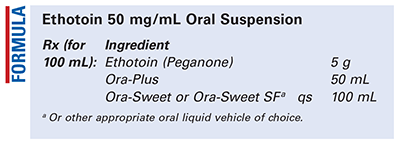US Pharm. 2018;43(1):47-48.

Method of Preparation: Calculate the quantity of each ingredient for the amount to be prepared. Accurately weigh or measure each ingredient. Obtain either the ethotoin powder or an appropriate number of ethotoin tablets pulverized to a fine powder. Add a small quantity of Ora-Plus and mix well to form a smooth paste. Add the remainder of the Ora-Plus geometrically and mix well. Add the Ora-Sweet or Ora-Sweet SF to final volume and mix until uniform. Package and label.
Use: Ethotoin is used in the treatment of epilepsy. This dosage form is for patients who are unable to swallow the solid tablets.
Packaging: Package in tight, light-resistant containers.
Labeling: Keep out of reach of children. Keep refrigerated. Shake well. Discard after ____ [time period].
Stability: A beyond-use date of 14 days when stored in a refrigerator may be used for this preparation.1
Quality Control: Quality-control assessment can include weight/volume, pH, specific gravity, active drug assay, color, rheologic properties/pourability, physical observation, and physical stability (discoloration, foreign materials, gas formation, mold growth).2
Discussion: Ethotoin (Peganone) is an anticonvulsant drug used in the treatment of epilepsy; it is a hydantoin similar to phenytoin and does not cause general central nervous system depression. It was approved in 1957 as Peganone (Abbott Laboratories) for treatment of grand mal (tonic-clonic) and partial complex (psychomotor) seizures and was acquired by Ovation Pharmaceuticals in 2003. It is commercially available as 250-mg tablets.3
Ethotoin (Peganone, C11H12N2O2, MW 204.2) occurs as a white, crystalline powder that melts at about 94°C and has a water solubility of 5.28 mg/mL; it is sparingly soluble in cold water and more soluble in hot water. It is freely soluble in alcohol and dilute aqueous solutions of alkali hydroxides.3,4 The commercial tablets also contain acacia, lactose, sodium carboxymethylcellulose, stearic acid, and talc. If the tablets are used as the source of drug, there may be an increase in viscosity owing to the sodium carboxymethylcellulose.3
For children aged 1 year and older, a dosage of 750 mg daily in 4 to 6 divided doses should not be exceeded. For adults, the initial dosage is 1 g or less daily in 4 to 6 divided doses, with subsequent increases over a period of several days; the maintenance dosage is 2 to 3 g daily in 4 to 6 divided doses. Each dose should be taken after eating, and the doses should be evenly spaced out.3
Ora-Plus is an oral suspending vehicle that accepts dilution of up to 50% or more with water, flavoring agents, or syrups and still retains its suspending properties. It has a pH of approximately 4.2 and an osmolality of about 230 mOsm/kg. It is a thixotropic vehicle with a viscosity of approximately 1,000 cps at 25°C. It contains purified water, microcrystalline cellulose, sodium carboxymethylcellulose, xanthan gum, carrageenan, sodium phosphate, and citric acid as buffering agents; simethicone as an antifoaming agent; and potassium sorbate and methylparaben as preservatives.5
Ora-Sweet syrup vehicle is a flavoring vehicle for oral extemporaneous preparations. It is flavored with a citrus-berry flavor blend and contains glycerin and sorbitol to prevent cap lock, a problem associated with many syrups. It is buffered to a pH of approximately 4.2 and has an osmolality of about 3,240 mOsm/kg. It contains purified water, sucrose, glycerin, sorbitol (5%), flavoring, sodium phosphate and citric acid as buffering agents, and potassium sorbate and methylparaben as preservatives.6
Ora-Sweet SF sugar-free syrup vehicle is a flavoring vehicle for oral extemporaneous preparations. It is a sugar-free, alcohol-free syrup flavored with a citrus-berry flavor blend. It is buffered to a pH of approximately 4.2 and may be used alone or in combination with other vehicles. It will tolerate a dilution to 50% with dissolved actives in water or suspending agents and still retain an acceptable taste. It has an osmolality of 2,150 mOsm/kg. It contains water, sodium saccharin, xanthan gum, glycerin, sorbitol, citric acid, and sodium citrate as buffers; methylparaben, propylparaben, and potassium sorbate as preservatives; and flavoring agents.7
Ora-Blend and Ora-Blend SF may be substituted for the separate Ora-Plus, Ora-Sweet, and Ora-Sweet SF, if desired.
REFERENCES
1. U.S. Pharmacopeia/National Formulary [current revision]. Rockville, MD: U.S. Pharmacopeial Convention, Inc; December 2017.
2. Allen LV Jr. Standard operating procedure for performing physical quality assessment of oral and topical liquids. IJPC. 1999;3:146-147.
3. Peganone (ethotoin) package insert. RxList. www.rxlist.com/peganone-drug.htm. Accessed December 4, 2017.
4. Ethotoin. In: PubChem open chemistry database. https://pubchem.ncbi.nlm.nih.gov/compound/ethotoin. Accessed December 4, 2017.
5. Ora-Plus product information. Allegan, MI: Perrigo; 2014.
6. Ora-Sweet product information. Allegan, MI: Perrigo; 2014.
7. Ora-Sweet SF product information. Allegan, MI: Perrigo; 2014.
To comment on this article, contact rdavidson@uspharmacist.com.






